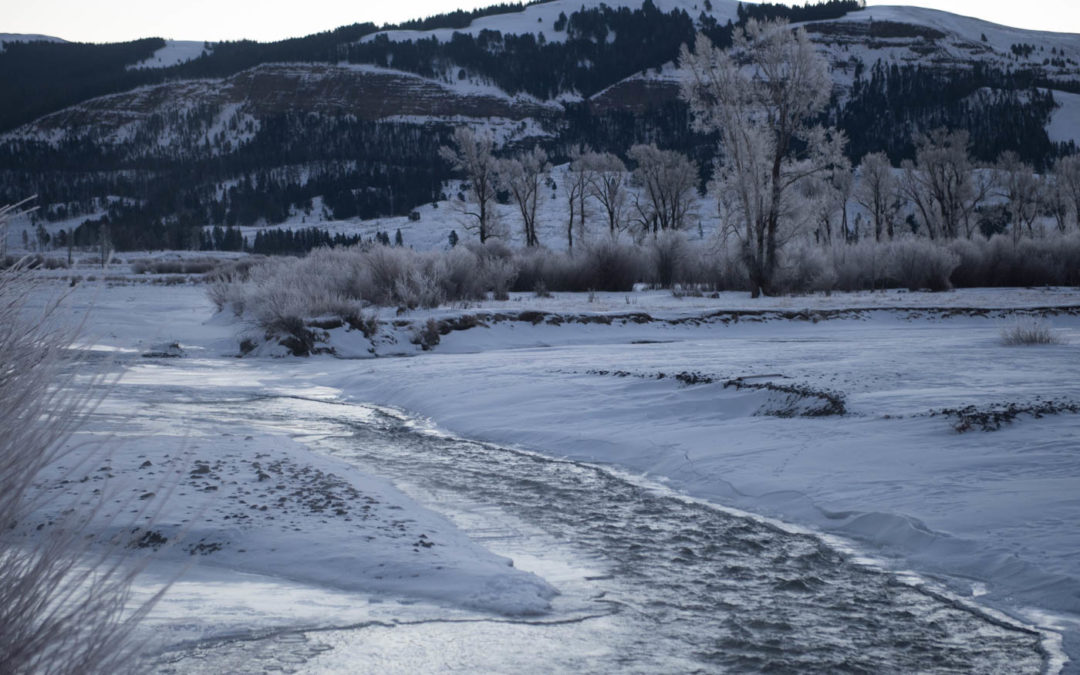Today’s agenda: wolves.
The class got a bright and early start to make the most of our time with Nathan Varley and Linda Thurston, two wildlife biologists in the region. Nathan was among the first volunteer field interns hired after the reintroduction of wolves in 1995. He and Linda met when she joined the Yellowstone Wolf Project in 1996, and the two eventually married.
As interns on the project, they earned $7 a day watching wolves for their efforts in the field. Linda went on to research the denning behavior of Yellowstone’s wolves for her master’s degree. Later, she worked in states outside the park to mitigate wolf predation on livestock. Nathan grew up in Yellowstone National Park in the tiny community of Mammoth Hot Springs. His parents have been biologists and park rangers that have lived and worked in the park for 3 decades. He was a firefighter during the summer of 1988, when massive fires blazed through the park, and studied elk predation by wolves for his Ph.D.
Today, Nathan and Linda own their own business, The Wild Side, LLC, which offers wildlife viewing tours, university level educational programs, biological research, and many conservation programs and services.
There were reports of an elk carcass by the Lamar River Trail, so we hopped on the shuttles to investigate. Along the way, we pulled over by Soda Butte Creek to watch another unique animal: a river otter. As soon as we got out of the shuttles, we saw the otter running along the creekside before jumping in to the water and out of our sight. Moments later, the otter resurfaced, but further up the creek and with a fish in its mouth. We watched in amazement as this creature gracefully popped in and out of the water, showing off the creek’s fresh catch of the day.
Once we finally made our way over to the Footbridge Pullout near the Lamar River Trail, we knew there had to be wolves nearby, as there was a small crowd of wolf-watchers looking through their scopes up the hill. The Lamar Canyon Pack was initially hard to spot, but we found them resting at the crest of a small hill, their bellies full thanks to a nearby elk carcass they had been feeding on. It was an extremely cold morning; the standing still in the shaded, snowy pullout wasn’t helping, but nobody complained. We were all happy to be watching one of Yellowstone’s most famous animals.
Linda informed us that another pack had been spotted a few miles north, so we hopped back in the shuttle and drove over to the Hellroaring Overlook. These wolves, members of the 8-Mile Pack, also seemed to be a bit meat-drunk and were extremely hard to locate in the spotting scopes. After a few minutes, Nathan found at least two of the wolves bedded down in the snow. With the exception of one black wolf occasionally raising its head to monitor the area, the others seemed to be sleeping soundly. Moments later, the wolves began to stir and ran over to a carcass to feed. It was a popular spot, as numerous bald eagles, ravens, and magpies were also taking advantage of the meal.
The sun was out and everyone was slowly warming up. We listened with amusement as Nathan and Linda explained some of the pack dynamics in the park. There are eleven known wolf packs in Yellowstone National Park, and each one has its own unique history and individual set of personalities. We learned that the highest cause of wolf mortalities inside the park tends to be from rivaling wolf packs, while wolf mortalities outside of the park are generally human-caused.

Ranger Fred Engel came by Hellroaring to talk to the students about his role at the park. Photo: Melanie Hill
After lunch, we sat down for one last group discussion with Nathan and Linda. We started the discussion with an intriguing question: why aren’t there wolves in our home state of Colorado? Should they be reintroduced? Or, will they return on their own, without human intervention? Would they even make it down to Colorado on their own? Wolf reintroduction is a controversial, emotion-filled topic. Colorado is part of the gray wolf’s native range, but wolves were eradicated from the state by the 1940s. Many of us agreed that if a reintroduction were to happen in Colorado, that there would need to be an industry and ecology involved with that process, like it was here in Yellowstone. It would require extensive outreach and education, to say the least.
While taking a break from lectures, some of the class was lucky enough to observe this quick little ermine as it popped out from the snow, jumped into Rose Creek, and swam to the other side. Dylan, one of the many budding photographers in the group, was able to snap some beautiful photos of this little stoat!
After dinner, we said goodbye to Nathan and Linda, and hello to our next guest speaker, John Byers. John walked us through an informative presentation on the annual cycle and lives of pronghorn in Yellowstone. In the morning, we’ll be heading out into the field with John to track pronghorn in Gardiner Basin, just outside the park.












